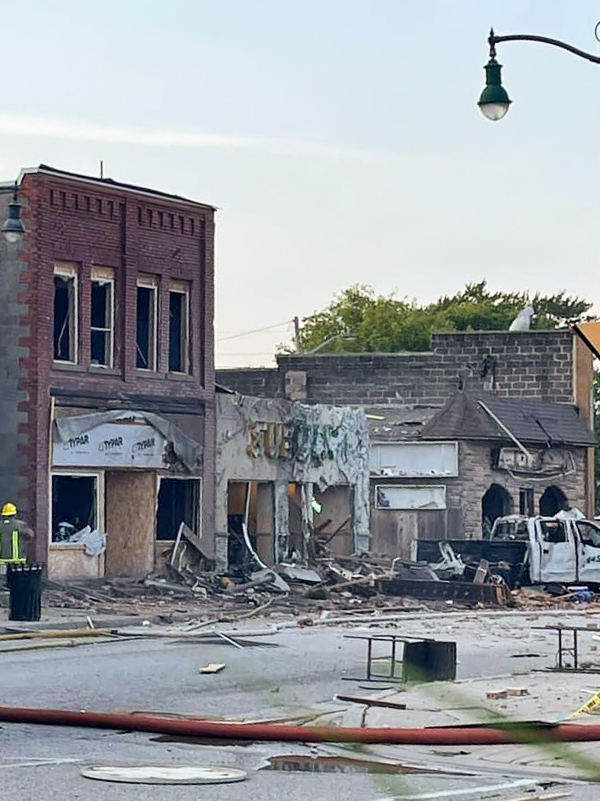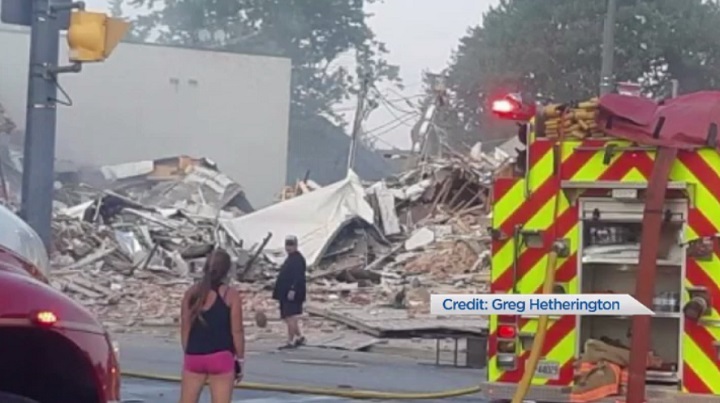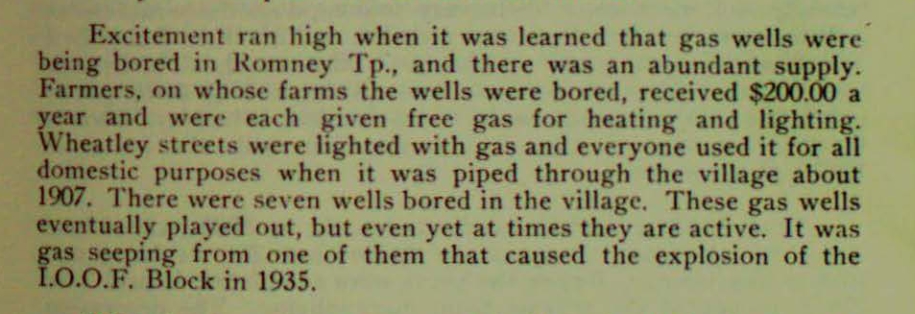Residents in the small southwestern Ontario community of Wheatley are being asked to stay away from the scene of Thursday’s large explosion as a result of an ongoing hydrogen sulphide gas leak which is continuing to hamper the work of first responders.

At least 20 people were injured in the blast, which occurred just after 6 p.m. in the area of Erie Street and Talbot Road in Wheatley’s core. Emergency crews had arrived in the area about 90 minutes prior after monitoring devices alerted an increased presence of gas.
During a conference call update Friday, local emergency and municipal officials confirmed that gas remained present in the area and was continuing to leak, furthering the risk of a possible second explosion.
“That is why the evacuation zone is two blocks, because we are basically surrounding the area with unoccupied buildings to try and reduce the risk,” Chris Case, Chatham-Kent’s fire chief, told reporters.
“We have our police and public works officials restricting people driving into the area so that we can keep the numbers down. At this time, we do not know what is happening under the ground.”
“We ask everyone to stay away from there. Please don’t go out gawking, et cetera, et cetera. It is an unsafe area and it’s unstable,” Chatham-Kent Mayor Darrin Canniff said.
Remarkably, no one was killed in the blast, however, at least three people were hospitalized for non-life-threatening severe injuries, while four were hospitalized for minor/moderate non-life-threatening injuries. Thirteen others were treated and released at the scene, Case said.
Three of the injured parties worked for the municipality, including one who needed emergency surgery.
Crews were in the process of evacuating people in the area when the explosion occurred. In all, more than 100 first responders descended on Wheatley to tend to the aftermath, including the OPP, Windsor EMS, and members of Ontario’s hazardous materials and urban search and rescue teams, officials said.
“I can’t overemphasize the amazing response of the first responder teams. They saved lives yesterday. There’s no doubt in my mind,” said Canniff.
“They were out there and evacuated a number of people from the area. If anybody’s seen the picture of the scene and the explosion, you know that if you were right in the heart of that, it wouldn’t have been good.”
It’s not yet clear exactly how many people have been displaced, but those who have been are asked to call 311 or contact the reception centre at Wheatley Arena. Businesses impacted will be contacted by Chatham-Kent’s Economic Development Team.
The city of London has also offered help to the community of Wheatley “whenever they may need it,” according to a tweet from Josh Morgan, London’s deputy mayor.
The ongoing gas leak is impeding the work of crews and investigators at the site, including members of the Ontario Fire Marshal’s Office. Officials say no work can be done, including finding out what specifically triggered the explosion, until the origins of the gas are determined.

Get breaking National news
“You literally have a rubble pile with a poisonous, toxic, corrosive and explosive gas coming up through the floor,” Case said. “I need someone to come and provide technical expertise about how we can stabilize the situation before we go anywhere near that building.”
The blast is the latest in what has been a summer of evacuations and state of emergency declarations for the residents of Wheatley, located just north of Point Pelee National Park and approximately 35 minutes southwest of Chatham.
Problems first began on June 2 when hydrogen sulphide gas was first discovered in the same area as Thursday’s explosion, triggering the evacuation of more than two dozen residents and the declaration of a state of emergency.
Hydrogen sulphide is a colourless, corrosive and poisonous flammable gas that smells like rotten eggs and can cause chest pain, difficulty breathing, vomiting and headaches.
- Officials stress Calgarians must save water after Bearspaw main break sees no drop in usage
- Yukon-Alaska border rocked by 3 earthquakes in final hours of 2025
- Snowmobiler dies in avalanche in Rocky Mountains in northeastern B.C.
- Canadians ring in 2026 with ‘invigorating’ polar plunges across the country
At the time, officials said the gas was consistent with a leak coming from an underground well, but that had not been determined, and it wasn’t clear where the gas was coming from.
By June 4, no gas was detected, and by June 19, the evacuation order had been lifted for most properties, excluding 9 Talbot St. and 15 Erie St. N. In a statement at the time, the municipality said they were working with the property owners to install gas monitors before lifting the state of emergency.
However, on July 20, nearly a month later, the community fell under a second evacuation order and state of emergency declaration after the gas monitor at 15 Erie St. N. detected hydrogen sulphide. At least 52 people in 23 homes and 13 businesses were evacuated around the area.
Analysis of a sample taken by hazmat crews suggested the location of the gas was “deep within the earth. A thermogenic gas response,” Case said Friday.
By July 22, the state of emergency had been reduced to just 15 Erie St. N., after readings over the prior 24 hours “indicated no presence of gas,” according to a release at the time.
The state of emergency declaration, however, remained active, and was still in place at the time of Thursday’s explosion.
In an update dated Aug. 3, the municipality said it had received a commitment from the province to investigate the gas leaks, identify the source, and determine what might be done to stop further incidents.
More than three weeks removed, however, Chatham-Kent officials expressed frustration Friday at what they say has been a lack of action. “It’s unacceptable for the people of Wheatley to live in fear,” Mayor Canniff said.
“We are continuing to ask the Ministry of Natural Resources and Forestry to take on the responsibility and control of the situation and use their authority and expertise to find the source and correct the issue.”
Don Shropshire, Chatham-Kent’s chief administrative officer, told reporters that while the municipality was responsible for the emergency response, the responsibility for managing abandoned gas wells, believed to be the source of the leak, rests with the province.
“Last night, to their credit, they did call in, but we’re asking them to take control of the situation and to lead the investigation to determine what the source of the gas is and what, if anything, can be done to avoid another event from occurring,” Shropshire said.
“As the mayor said, we don’t want people living in fear. We want the province to step up and take control. We do not have either the legislative authority to ask property owners to do the investigation, nor do we have the mandate — that rests with the province.”
He noted that since the previous gas-related incidents in Wheatley, the province, at the municipality’s urging, had formed a working group to look into the leaks, as well as the issue of abandoned gas wells across southwestern Ontario.
“They’ve identified a person to serve as project lead for that. They have been in communications with us,” he said.
“I think the frustration we’ve had is wanting to have them actually take the lead and start controlling the investigation and trying to get information to identify the source and what steps can be taken to mitigate.”
980 CFPL reached out to the province for comment but did not receive a response by publishing time. Municipal officials say they have requested a meeting with the province to demand a formal plan of action.
Shropshire said while there was a sense of relief among the public that no one died and that more people weren’t hurt, there was “a lot of frustration” knowing this was the third gas-related incident the community has seen in as many months.
Thursday’s explosion isn’t the first of its kind to be recorded in Wheatley.
According to a publication released in 1951 by the Kent Historical Society, the community was the scene of an blast which destroyed the I.O.O.F. Block in the mid-1930s, the result of gas seeping from an abandoned well.
“Excitement ran high when it was learned that gas wells were being bored in Romney (Twp.), and there was an abundant supply,” the publication states.
“Farmers, on whose farms the wells were bored, received $200 a year and were each given free gas for heating and lighting. Wheatley streets were lighted with gas and everyone used it for all domestic purposes when it was piped through the village about 1907.”
Seven gas wells were bored in Wheatley, the publication says, adding that they “eventually played out, but even yet at times they are active” — alluding to the leak which caused the blast.
Asked about this historical detail Friday, Shropshire said officials were aware of the 1930s explosion, but had not heard of any subsequent events.
“We’ve been told by some private sector folks that the most probable cause of this gas leak is that it might be an abandoned gas well,” he said.
“Our area has hundreds, if not thousands of abandoned gas wells. They stretch from Niagara Peninsula to Windsor.”
Shropshire noted that the municipality has asked and has tried to collect information and historical evidence that may aid them in their search for the source of the current gas leak.
“The Ministry of Natural Resources and Forestry records, some of those are quite old. We have a record that there were at least two abandoned gas wells in close proximity to where the explosion was. But the records are only good within 200 metres,” he said.
“If you draw a 200-metre circle around the where the explosion site was, that would include a large part of downtown Wheatly,” he added.
“Until you get some better information … it’s not practical to go in and start digging up holes (and) trying to identify where this is, because every time you do that, you’re at risk of having another type of an event.”
— With files from Nick Westoll















Comments